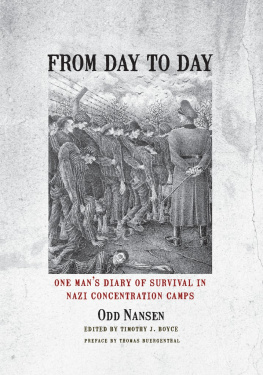This edition is published by Papamoa Press www.pp-publishing.com
To join our mailing list for new titles or for issues with our books papamoapress@gmail.com
Or on Facebook
Text originally published in 1956 under the same title.
Papamoa Press 2018, all rights reserved. No part of this publication may be reproduced, stored in a retrieval system or transmitted by any means, electrical, mechanical or otherwise without the written permission of the copyright holder.
Publishers Note
Although in most cases we have retained the Authors original spelling and grammar to authentically reproduce the work of the Author and the original intent of such material, some additional notes and clarifications have been added for the modern readers benefit.
We have also made every effort to include all maps and illustrations of the original edition the limitations of formatting do not allow of including larger maps, we will upload as many of these maps as possible.
AMERICAS CONCENTRATION CAMPS
THE FACTS ABOUT OUR INDIAN RESERVATIONS TODAY
BY
CARLOS B. EMBRY
FOREWORD
THE Indian is the worst fed, the worst clad, and the worst housed of any racial group in the United States, It follows that he has the highest illiteracy rate. He gets the poorest schooling, the poorest medical care, and the poorest government services of anyone in the country.
While the average life of a white person in the United States is now sixty-eight, and that of a Negro is sixty, the life expectancy of a baby born on the Papago reservation in Southwestern Arizona is seventeen years. The figure is approximately the same for the Navajos, the Hopis, the Utes, the Sioux, and other reservation Indians.
Poor housing is one of the causes of this discrepancy. The typical house of the Indian of the Southwest is the hogan . This is a one-room dwelling built of logs and mud, with a dirt floor and no window; or a small dome-shaped house made by plastering clay over grass on a framework of poles. This is the home for the entire family. The size of the average family unit is slightly more than seven persons. There are no toilets, no electric lights, and no telephones. There is almost no furniture, seldom a stove or bed. Heatings provided by a fire on the dirt floor in the middle of the room. A hole is left in the ceiling to allow the smoke to escape.
People living near a reservation frequently call their Indian neighbors filthy. Dirt and disease are the inevitable results of overcrowding and the absence of proper sanitary facilities. The reservation Indian usually has to carry water for considerable distances.
Lack of ample and well-balanced food is another cause of the high mortality rate on the reservations. Fried bread, potatoes, and coffee are the mainstays of the desert Indians diet, with a little mutton or beef on special occasions. There is a woeful deficiency of protein foods, including milk, butter, eggs, and green vegetables.
As a result of this sub-standard of living, the Indian has an extremely high death rate from tuberculosis, diarrhea, dysentery, trachoma, dental caries, skin and venereal diseases, in addition to malnutrition, or simply starving to death.
Opportunities for physical advancement on Indian reservations are practically non-existent. The Indian, as an individual or as a tribe, cannot buy, sell, mortgage, or lease land on a reservation without the consent of the Government. This statement does not begin to convey the handicaps under which he is forced to operate. He lives in a capitalist economy, in which the bulk of business is carried on through credit, but it can be said of the Indian that he has no credit whatsoever. Just consider what would happen if the mortgages on all the farms and farm equipment throughout the Middle West were called tomorrow morning. If this unlikely eventuality came to pass, the inhabitants of that prosperous farming region would be reduced to the condition of the reservation Indians.
In the early sixteenth century Pope Paul III observed that Indians were human beings. At the time this was considered a momentous pronouncement. I think we all agree today that the Indian is not only a human being, but that he is potentially a valuable citizen of the United States. Yet to this very day we hold his race in bondage. We have set him apart as an inferior, incapable of being integrated into our society. We have fostered and perpetuated this condition through the Bureau of Indian Affairs in the Department of the Interior. This Bureau is a government within a government, employing some 12,500 persons, predominantly white in the lower echelons, and entirely white at the top. It is an archaic governmental agency that should have been abolished when the Freedmans Bureau for Negroes was discontinued.
Until a few years ago I myself took it for granted that the Indian had now been integrated into our society, and that he enjoyed all the privileges and freedoms of any other citizen. My knowledge of the subject was, in fact, pretty much limited to what little I remembered from what little I had learned in school texts; I had a nodding acquaintance with Pocahontas, Sitting Bull of the Sioux, and the Bird Woman who accompanied the Lewis and Clark expedition.
Since that time I have met and talked with literally thousands of Indians, from the Great Smokies in North Carolina to the Pacific Coast, and from the Canadian border to the Rio Grande. The first important thing this did for me was to wipe out all my preconceived notions about the Indians of North America. The more I learned how ignorant I had been about our Red brothers, the more disturbed I became. I still do not consider myself an Indian expert, but only a layman who has had the good fortune to come in contact with many types of Indians and who has given much time and thought to their present plight. Yet I feel that as a layman I may be in a better position than an expert to pass on my findings to my white fellow-countrymen, whose misconceptions may resemble my own before I started this study.
Fundamentally, Indians have the same virtues and the same vices as people of other races. As with other people, it is not difficult to find striking contrasts among them. Some are religious and conscientious, others have a devil-may-care attitude. Some are ambitious, others are lackadaisical.
In my travels I have met all sorts. On the seamier side there was Uncle Joe, whom I visited at Pawhuskie, Oklahoma, in a one-room, run-down cottage, and who passed around to the young bucks of the neighborhood, a gallon jug half-filled with a colorless fluid of high potency, imbibing himself until he passed out completely. In Hominy, only a few miles away, I met another aged Indian who was a very different kind of man. He was to conduct the religious services at his church that night, and he spoke at length and wisely about his people.
I also had the experience of having my automobile stolen by two Cherokees in Oklahoma. The next afternoon they were found having a grand time, swapping my clothes for drinks, and arranging to trade my shaving kit for more gas. They had already absorbed a bottle of hair tonic and were making inroads on a bottle of cough medicine found in my luggage.










